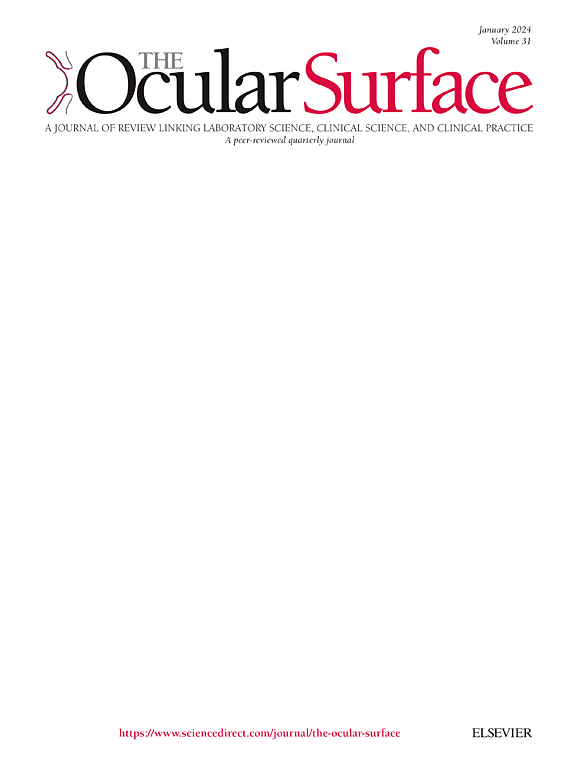局部雄激素治疗干眼症的随机对照试验
IF 5.6
1区 医学
Q1 OPHTHALMOLOGY
引用次数: 0
摘要
目的评价眼睑雄激素凝胶治疗中重度干眼病的安全性和有效性。本文章由计算机程序翻译,如有差异,请以英文原文为准。
A pilot randomized controlled trial of topical androgen treatment in dry eye
Purpose
To evaluate the safety and efficacy of eyelid androgen gel application to treat moderate to severe dry eye disease.
Methods
Twenty four eyes of 24 subjects (12 eyes per arm) were randomized to either eyelid testosterone or vehicle gel. Subjects received either 17β-Hydroxyandrost-4-en-3-one) 4.5 % wt./wt. or vehicle gel, applied twice daily 12 h apart for 4 weeks. Outcome parameters were monitored at 2-, and 4-weeks during dosing, and at 4-, and 8-weeks following dosing cessation.
Results
Significant positive differences were found in the androgen arm only, for Schein symptom score, tear meniscus height (TMH), fluorescein tear breakup time (fTBUT) and meibum score (repeated ANOVA, all p = 0.046 or less for each arm comparison) at all follow-up visits compared to baseline. For example, fTBUT in the androgen arm at 4 weeks was 6.2 ± 1.5 s compared to baseline, 3.3 ± 0.9 secs p< 0.001 (Dunnett's test, 95 % CI [1.838, 3.829]). No change was observed for either arm for staining, tear osmolarity, OSDI, non-invasive breakup time (NIBUT), serum lipid levels or hematocrit. Serum testosterone increased ∼ 9-fold in females (paired t-test; p = 0.006; CI [-240.2, −55.6]) in the androgen arm, but not males (paired t-test; p = 0.727; CI [-25.9, 31.2]).
Conclusions
Eyelid androgen gel application, 4.5 % wt./wt., was effective in improving tear fTBUT, symptoms, TMH and meibomian secretion grade in dry eye patients. Future research requires a larger sample size, outcome measure variability reduction and formulation optimization for absorption, androgen type, and dosing regimen.
求助全文
通过发布文献求助,成功后即可免费获取论文全文。
去求助
来源期刊

Ocular Surface
医学-眼科学
CiteScore
11.60
自引率
14.10%
发文量
97
审稿时长
39 days
期刊介绍:
The Ocular Surface, a quarterly, a peer-reviewed journal, is an authoritative resource that integrates and interprets major findings in diverse fields related to the ocular surface, including ophthalmology, optometry, genetics, molecular biology, pharmacology, immunology, infectious disease, and epidemiology. Its critical review articles cover the most current knowledge on medical and surgical management of ocular surface pathology, new understandings of ocular surface physiology, the meaning of recent discoveries on how the ocular surface responds to injury and disease, and updates on drug and device development. The journal also publishes select original research reports and articles describing cutting-edge techniques and technology in the field.
Benefits to authors
We also provide many author benefits, such as free PDFs, a liberal copyright policy, special discounts on Elsevier publications and much more. Please click here for more information on our author services.
Please see our Guide for Authors for information on article submission. If you require any further information or help, please visit our Support Center
 求助内容:
求助内容: 应助结果提醒方式:
应助结果提醒方式:


